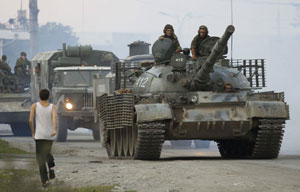(lead article)
Moscow invades Georgia
to reassert domination
Claims defense of Ossetian, Abkhaz rights

|
|
Reuters
|
|
Russian troops roll through Alagir, North Ossetia, on their way to South Ossetia August 10.
|
BY SAM MANUEL
AND SETH GALINSKY
WASHINGTON, August 14—Soon after signing a cease-fire agreement August 12, Russian troops moved deeper into Georgia, effectively dividing it in half. At one point they were just 30 miles from the capital, Tbilisi.
“One can forget about any talk about Georgia’s territorial integrity,” Russian foreign minister Sergey Lavrov told reporters August 14.
Moscow is using its invasion of Georgia, a nation historically oppressed by Russia, to reassert its dominance in the region. It cynically claimed its military action was in response to Georgian “genocide” against the people of South Ossetia, a region the Georgian government considers to be part of its territory.
The Russian government had been preparing its operation for months, as shown by the speed and scope of its rapid advance.
Russian troops occupied Gori, Georgia, putting Moscow in control of the main east-west road through the country, isolating Tbilisi. The Russian military sabotaged airfields, naval facilities, and radar installations, systematically degrading Georgia’s military capabilities.
A Russian tank commander in Gori bragged to the New York Times that Georgian president Mikhail Saakashvili “doesn’t seem to understand that the Russian army is much stronger than the Georgian army. His tanks remain in their places. His air force is dead. His navy is also. His army is demoralized.”
A six-point cease-fire accord between Moscow and Tbilisi was brokered August 12 by French president Nicolas Sarkozy. It called for Russian troops to withdraw to where they had been stationed before the conflict broke out, but also, at Moscow’s insistence, included a clause allowing Russian “peacekeeping” forces to “implement additional security measures.”
The fighting began August 8 when Georgian troops moved to occupy South Ossetia after skirmishes between Georgian troops and Ossetian military forces. Some press reports say that hundreds were killed by the Georgian offensive into South Ossetia. The Russian government charged that 2,000 civilians were killed and accused Saakashvili of genocide.
Anna Neistat, a member of Human Rights Watch who visited the main hospital in Tskhinvali, the South Ossetian capital, told the London Times that the number of deaths the Russian government says were caused by the Georgian shelling was exaggerated. She said the hospital reported that 44 people, mainly civilians, were killed.
Moscow poses as defender
Posing as a defender of the rights of South Ossetia and Abkhazia, another region Georgia claims is part of its territory, the Russian government has backed supporters of independence in both areas. Moscow also issued Russian passports and gave citizenship to thousands of Abkhaz and Ossetians. Russian president Dmitry Medvedev argued that the invasion of Georgia was necessary because “our citizens” had come under attack.
Tensions in both regions sharpened with the election in Georgia of Saakashvili in 2004. He campaigned on the promise to “reintegrate” South Ossetia and Abkhazia into Georgia.
The Georgian president also established warm relations with Washington. Since 1997 Washington has given his government $277 million in military aid. In return, Saakashvili sent 2,000 troops to fight under U.S. command in Iraq.
On August 13, the day after the cease-fire was signed, U.S. president George Bush announced he was sending “humanitarian aid” to Georgia.
“We will see U.S. military ships entering ports despite Russians blocking,” claimed Saakashvili. “These will be serious military ships.”
But the Pentagon said that it is only sending cargo planes with tents, sleeping bags, and medical supplies, no military ships. “I don’t see any prospect for the use of military force by the United States in this situation,” U.S. defense secretary Robert Gates said at a Pentagon briefing. “Clear enough?”
History of Russian domination
Russian governments have a long history of dominating not only Georgia but other oppressed nations in the former Tsarist empire. The exception was during the Bolshevik government under Vladimir Lenin that came to power after the Russian Revolution of October 1917.
Under the tsar, nations oppressed by the Russian empire such as Georgia were denied their own language and culture. Russian capitalists exploited their natural resources.
That changed when the Bolshevik-led workers and farmers government took power. The revolutionary leadership forged a voluntary federation of nations, which included Georgia, based on the power of the soviets (councils) of workers and farmers in those countries: the Union of Soviet Socialist Republics (USSR). The new federation demonstrably applied affirmative action to develop the economies and cultures of the poorer nations in order to close the gap between them and Russia (see article on Lenin’s policy on this page).
Under the Bolsheviks South Ossetia was an autonomous region. Ethnic Osssetians speak their own language. Abkhazia was also granted autonomy under the Bolsheviks, but Joseph Stalin later reversed this and incorporated the province into Georgia.
The Bolshevik internationalist policy of a voluntary federation of Soviet republics began to be replaced with the old Russian chauvinism in the mid-1920s by an emerging privileged, bureaucratic caste headed by Stalin. When the USSR collapsed in the early 1990s, the other Soviet republics declared independence, including Georgia.
With the breakup of the Soviet Union, officials in South Ossetia and Abkhazia pressed for independence and association with Russia. Sporadic battles with Georgian forces occurred in both regions. Abkhazia declared independence from Georgia in 1999.
Related articles:
Bolshevik policy on rights of oppressed nations
| 


